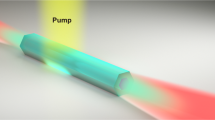Abstract
Nonlinear optical effects, including second- and third-harmonic generation, and multi-photon luminescence, are found to be excited much more efficiently via evanescent wave coupling. Taking this advantage, we establish a microfiber-based compact device to extract the magnitude and phase information of ultrafast pulse laser. The sensitivity of this configuration can be down to femto-joule level.
Access provided by Autonomous University of Puebla. Download conference paper PDF
Similar content being viewed by others
1 Introduction
Semiconductor nanowaveguides (NWs), such as ZnO nanowires [1], CdSe nanobelts [2], and GaSe [3] nanoribbons, have drawn a widespread attention as nonlinear optical (NLO) media. The large refractive index and scale effect offer them the ability to strongly confine the light within a sub-micron scale. Recently, the evanescent wave coupling (EWC) technique is emerging as an efficient method for NLO optical excitation [4, 5]. We here demonstrate enhanced efficiencies for second-harmonic and third-harmonic generation (SHG/THG) and multi-photon luminescence (MPL) via this waveguide excitation. Particularly, second-order stronger MPL in intensity can be obtained from a single CdSe nanowaveguide, in contrast to that generated by free-space excitation, which can be hardly seen under the same excitation power.
2 Materials and Experimental Setup
The NWs used here were all synthesized via vapor-liquid-solid processes. The optical image and scanning electron microscopy show the nanostructures with smooth surface and good uniformity along the longitudinal direction. EWC technique is sketched in Fig. 1a. Briefly, individual NW was picked up and placed on the edge of a MgF2 substrate, protruding out for tens of micrometers. A microfiber tapered from a standard optical fiber (SMF-28, Corning) was attached to the NW firmly via Van der Waals and electrostatic attractions, as shown in Fig. 1b. In this way, the excitation laser can be coupled from optical fiber into the NW with up to 90% efficiency. For comparison, a spatial light excitation regime is also implemented by focusing the laser on to the suspended NW through a 50× objective lens, which also worked for epi-detection in both excitation regimes.
3 Results and Discussion
We compared the NLO response of the two excitation regime, and the spectra results under the same input power are presented in Fig. 1d. It is obvious that the intensities of all three NLO effects are stronger under the EWC excitation. Specifically, the MPL from an individual NW was hardly observed under spatially focused excitation regime, while under EWC excitation, the MPL emission showed a bright and distinct pattern, as shown in Fig. 1c.
The enhancements of NLO effects can be attributed to two reasons. On one aspect, after coupled into a NW, the light is confined in a scale beyond the diffraction limit, leading to a much higher energy density within the nanostructure. On the other, the light–material interaction distance is largely augmented as the light guiding along the NW. Both aspects will benefit the generation of NLO effects. Provided the high signal-to-noise ratio by waveguide excitation, we thus observe a fourth-order excitation power dependence of three-photon luminescence, and we attribute it to surface defect mechanism based on the recombination of free carriers [2].
Taking the advantage of the high efficiency in NLO generation, we further developed a configuration by coupling pulsed laser from both ends of a NW simultaneously, so that a SHG-based frequency-resolved optical gating method for ultrafast pulse measurement can be practiced in this compact device. The phase and amplitude of a pulse series are extracted as shown in Fig. 2, and the sensitivity can reach down to femto-joule [1, 3]. This microfiber-NW geometry is compatible with standard fiber system and may promote the functionalization of nonlinear optical circuits in the future.
References
Yu J, Liao F, Gu F, Zeng H (2016) Frequency-resolved optical gating measurement of ultrashort pulses by using single nanowire. Sci Rep 6:33181
Yu J, Liu F, Gu Z, Gu F, Zhuang S (2018) Efficient higher-order nonlinear optical effects in CdSe nanowaveguides. Opt Exp 26:6880–6889
Liao F, Wang Y, Peng T, Peng J, Gu Z, Yu H, Chen T, Yu J, Gu F (2018) Highly efficient nonlinear optical conversion in waveguiding GaSe nanoribbons with pump pulses down to a femto-joule level. Adv Opt Mater 6:1701012
Gu F, Zhang L, Wu G, Zhu Y, Zeng H (2014) Sub-bandgap transverse frequency conversion in semiconductor nano-waveguides. Nanoscale 6:12371–12375
Gu F, Cui H, Liao F, Lin X, Wang H, Zeng H (2016) Mode tailoring in subwavelength-dimensional semiconductor micro/nanowaveguides by coupling optical microfibers. Opt Exp 24:23361–23367
Author information
Authors and Affiliations
Corresponding author
Editor information
Editors and Affiliations
Rights and permissions
Copyright information
© 2021 Springer Nature Singapore Pte Ltd.
About this paper
Cite this paper
Yu, J., Cao, Y., Liu, F., Gu, F. (2021). High-Efficient Generation of Nonlinear Optical Effects in Semiconductor Nanowaveguides. In: Xu, L., Zhou, L. (eds) Proceedings of the 8th International Multidisciplinary Conference on Optofluidics (IMCO 2018). IMCO 2018. Lecture Notes in Electrical Engineering, vol 531. Springer, Singapore. https://doi.org/10.1007/978-981-13-3381-1_7
Download citation
DOI: https://doi.org/10.1007/978-981-13-3381-1_7
Published:
Publisher Name: Springer, Singapore
Print ISBN: 978-981-13-3380-4
Online ISBN: 978-981-13-3381-1
eBook Packages: EngineeringEngineering (R0)






